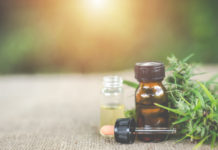
Do you know what to look for (and avoid) in sunscreens? This natural sun protection primer reveals which ingredients can keep you safe and healthy.
The word’s definitely out about the importance of natural sun protection. We’re well aware that the sun’s UV rays are the major cause of skin cancers. With a few simple measures, you can keep your skin safe and still enjoy the summer sun.
Choose a natural sunscreen
Concern about sunscreen ingredients has been mounting, making it difficult for consumers to choose products that are healthy and effective.
What to look for
Use a broad spectrum (effective against UVA and UVB rays) sunscreen with a sun protection factor (SPF) of at least 30. It’s worth noting that a higher SPF doesn’t offer a lot of extra protection. For example, SPF 30 sunscreen will filter about 97 percent of the sun’s rays, while SPF 50 sunscreen will filter 98 percent.
If you’re concerned about absorbing sunscreen ingredients through your skin, select a product that contains mineral sunblocks such as zinc oxide and titanium oxide. These ingredients aren’t absorbed, and they act by reflecting the sun’s rays. Choose a lotion rather than a spray, since airborne droplets can be inhaled and cause lung irritation.
What to look out for
The Environmental Working Group (EWG), a nonprofit health and environmental watchdog, has raised concerns about the safety of a number of sunscreen ingredients. They’ve flagged oxybenzone and octinoxate, which they report as having hormone-disrupting effects and moderate rates of skin allergies. The EWG also warns against products containing retinyl palmitate, a vitamin A derivative, which has been associated with skin tumours in mice.
Remember that sunscreen can create a false sense of security and lead to spending too much time in the sun.
Sun-safety resources
- EWG’s 2015 Guide to Sunscreen: ewg.org/2015sunscreen
- The Canadian Dermatology Association: dermatology.ca
- The Skin Cancer Foundation: skincancer.org
Dodge the rays with a few smart moves
Before heading outside, check the UV index at weather.gc.ca. Try to avoid direct sunlight at times of the day when it’s most intense: 10 am to 4 pm. Plus, take these precautions to protect your skin.
The UV index, explained
| UV index reading | Recommended sun protection |
| 0 to 2 | No protection is required. |
| 3 to 7 | Protection is required. Seek shade during midday hours, apply sunscreen, and wear protective clothing. |
| 8 to 11+ | Extra protection is required. Try to avoid being outside during midday hours. Protective clothing and sunscreen are a must. |
What to wear
Clothes are your first line of defence against damaging rays. Some stores even carry special sun-safe garments for children and adults.
- Cover up with bright, tightly woven fabrics that deflect rays.
- Wear a wide-brimmed hat that provides coverage for your neck.
- Wear sunglasses that protect your eyes from 99 to 100 percent of UVA and UVB light.
What to do
These sun-safety actions are essential, whether you’re at the beach or out and about.
- Be generous with the sunscreen: use about 2 Tbsp (30 mL) for your body and 1 tsp (5 mL) for your face and neck.
- Allow sunscreen to dry before going into the sun, and reapply it every two hours.
- If you’re lazing outside, set up a beach umbrella for a refuge from the sun.
- Use a lip balm with a minimum SPF of 15, and reapply every couple of hours.
- Boost your skin’s resistance to the sun through a diet packed with fruits and vegetables.
Do you need more vitamin D?
If you avoid the outdoors when it’s sunny, get your vitamin D levels tested by a health care practitioner. Since your body manufactures this vitamin through exposure to the sun, you may need to supplement.
8 Sun-Safety Tips for Kids
- Keep babies younger than one year old out of direct sunlight—either in the shade or under the canopy of a stroller.
- For children older than one year old, test sunscreen for an allergic reaction by first applying it to a small area, such as the child’s wrist.
- Promptly change kids out of wet clothing, as it provides less UV protection.
- Look for shaded play areas.
- Schedule a daily quiet time or nap during peak sun hours.
- Watch for symptoms such as headache, thirst, and fatigue in kids, as they’re more susceptible to heat exhaustion. Heat exhaustion can quickly progress to heat stroke, a life-threatening condition that must be treated right away. Signs include dry skin, muscle cramps, nausea, and vomiting.
- Always bring along a lot of water to avoid dehydration.
- Be a good example. Use sun safety precautions and teach them to your children.





